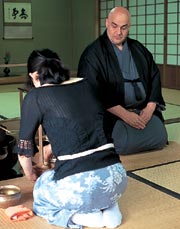| Web Japan > NIPPONIA No.30 > Special Feature* |
|
|
|
NIPPONIA No.30 September 15, 2004
|
Part of the floor has been cut out to make a hearth for a charcoal fire. The sound of boiling water comes from the kettle close to where a woman is kneeling. She stretches out her hand to pick up the bamboo tea scoop.
"Try to move more naturally. Relax, and aim for maximum flexibility." We are in the middle of a tea ceremony class. The teacher is Randy Channell, a native of Canada. His ceremonial tea name is Soei, and he is an associate professor of the Ura Senke School of the tea ceremony. He teaches four times a week at his home in Kyoto's Kamigyo Ward, and at Nashinoki Shrine.
"Before guests visit for a cup of tea, the host tidies the traditional garden, chooses and hangs up a scroll, prepares the tea bowls and utensils, and arranges the flowers. These things are all part of Kyoto's traditional culture, and the tea ceremony encompasses all of those traditions. It also helps one to appreciate the sincerity required when extending hospitality to guests."
Channell came to Japan 20 years ago. Before that he was in Hong Kong studying Kung Fu, keen to master techniques made famous in Bruce Lee movies. He moved to Japan to hone his skills by studying Japanese martial arts.
"I was looking for the 'Way'—a way of life based on some civilizing ideal. Of course, I was still too young to understand that at the time, when I was in Hong Kong."
He went to live in Matsumoto, in Nagano Prefecture, central Japan. There he studied many martial arts—kendo (swordsmanship using a bamboo "sword"), iaido (drawing the sword and cutting at the same time), kyudo (archery), naginata (wielding a sharpened pole), and nitoryu (using two swords). He began studying the tea ceremony at the same time.
"But the tea ceremony was just a side interest in those days. I was totally into martial arts. Then about 10 years ago, I became unsure about the road I was taking. It seemed that the 'Way' I was studying wasn't right for me after all."
He decided to start from scratch, by taking a break from martial arts and concentrating on sado, which means the "way"(do) of tea (sa). He moved to Kyoto in 1993 and applied to study at a school teaching Ura Senke traditions. He got in.
"After practicing martial arts for a decade, then the tea ceremony for the next decade, I now realize that the most important thing is humility. If a teacher is humble, he can learn from his students and from mistakes. And I now know that searching for the 'Way' takes a lifetime."
Channell's favorite form of transportation is his 100 cc scooter. He uses it to travel all over the city. "Kyoto has a lot that is typically Japanese. But at the same time, it's a very international city. That's what makes it a great place to live."
One of his hobbies is playing the blues harp, a kind of harmonica. On weekends, he sometimes goes out to an open-mike session and plays with the musicians there.
And the future? "Someday, I'd like to open my own dojo in the Kyoto suburbs and teach both the tea ceremony and martial arts."
|
|
|
||||||||
|

